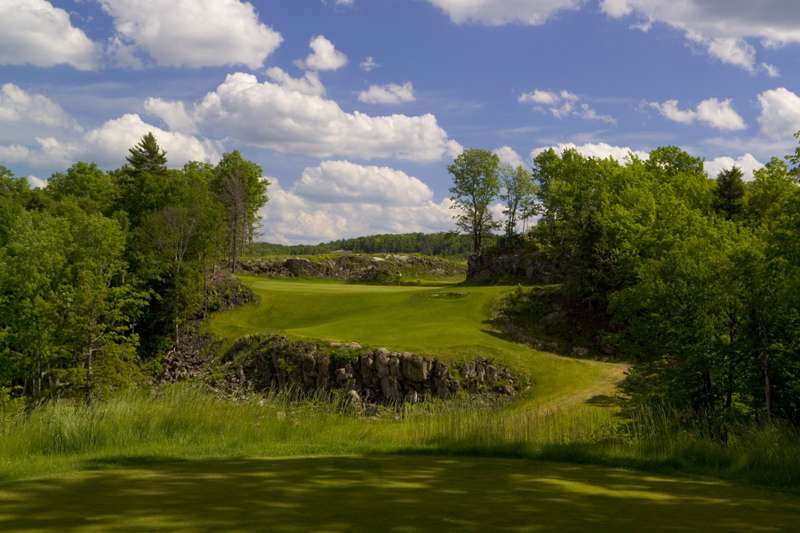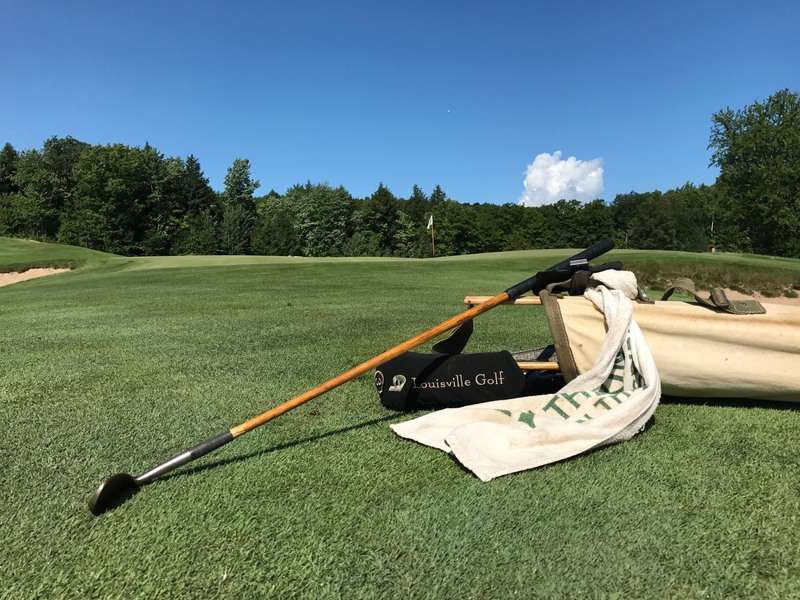Home › Forums › Welcome to The Walking Golfer Forum › GCA – Half science – half art really!!!
- This topic has 6 replies, 3 voices, and was last updated 7 years, 1 month ago by
Melvyn Morrow.
-
AuthorPosts
-
April 2, 2018 at 9:24 pm #3626
Brent Gremillion
ParticipantThat’s great for you to have such land to work with. The one major problem with your point is that God did not make all Coast land such as that. Where I live, if we leave the land as God created it we would get this:
http://www.compass-points.com/iom_images/BigBranchMarsh.jpg
When you figure out how to make a golf course out of that without using art, science, architecture, and moving dirt, please let me know.April 2, 2018 at 10:36 pm #3627Ben Cowan
KeymasterMelvyn,
In regards to fairway width. Many fairways have shrunk due to irrigation systems and tree planting programs which encroached fairways. This is from a US perspective. I agree completely that most fairways at private US clubs are overwatered. I however do NOT want any Governing body telling them how to properly maint their course.
I agree with you Golf Architecture or design should be about the land and common sense ways to make the golfer think. I wanna say that if a site is rocky, I have no problem with using TNT to make cool non-uniform fairways. People used to go as far as they could see (build as many holes as they could afford) and then go a little farther. Not this debt ridden society.
I really like the Aussie maint meld (haven’t been there though), they seem to focus on fairway and greens and let the rough go natural. I don’t see Art in Architecture, if one does that means possibly the course was over-shaped. Science is needed when you are focused on running your greens at 12 or more imo. No science in Golf Arch imo, even Donald Ross was afraid of the man with the yard stick….
The problem in the US is too much money is allocated to the clubhouse (money loser) and not enough attention to the golf course and making golf affordable to a bigger audience, which has lead to more natural designed destination golf courses in the US.
What about TNT fairways or making man made gully’s? Man made burns? Design elements that are common sense and create avenues for strategic design!
-
This reply was modified 7 years, 1 month ago by
Ben Cowan.
April 3, 2018 at 11:18 am #3628Melvyn Morrow
ParticipantBen – the art if you believe in art as related to any form of golf course design would be – well in my way of thinking relate to first of all The Land is Fit for Purpose. As for others telling clubs what to do – well again we have to look at location, climate and then add common sense.
As for rocks, leave them, use them, we need designers to think outside the box – rocks are great hazards and should be used if it makes the Hole more challenging therefore entertaining. Many course have worked around rocks and that will lesson the pressure on the budget strings.
The main problem in the USA is that you spend too much money first on the course design , then on building them, destroy everything first then rebuild from bedrock – why – what the point, we need to remember that the natural and Nature should be involved with the design and build of the course. Just too much looking for perfection, but golf has never been about perfection, its about challenging oneself first, then the course and anyone else if appropriate . We must stop being fixated on the super engineered, super manicured super Green and smooth courses and get to grips with the fundamentals that defines The Royal & Ancient Game of Golf. Once we do that the toys will no longer matter, in fact players will become golfers and put away childish things like carts (unless required for age/medical reasons) GPS’s Distance devices and may even revert back to Hickory Clubs with gutty ball.
Courses should be judged by how they play using Hickory, that really defines the game and IMHO the quality of the course for it pulls you the golfer back into the realms of golf – the real stuff when its your abilities that achieve the result not the over friendly course and equipment more so the ball. As for trees, – there is no place for trees on the course nor do I believe that they should be in the rough because trees are thirsty things and consume fasts amount of water Either the abundance of water or its lack has a serious effect upon the course. No, love trees but not on a course.
Again we keep coming back is the land fit for purpose, with all your man made gullies, burns etc, – courses need penal otherwise strategic does not get a look in – it just does not exist.
In my early days some of the old 9 Holes course in Scotland were penal, they allowed the golfer the facility to retreat backwards if he fell fouls of the penal bunkers and hazards but never really was it possible to go forwards, to cost was just too great, – alas today very few course survive that teaches golfers the wisdom of how to play, how to read the land and more so the Hole. A lesson my father taught me was pull the shot short or suffer the consequences, being young, I always went for it while my father was way out ahead winning each Hole by orienteering to the Pin. Golf is not all about wham bam thank you mam, we have to judge our ability with that of the design (lay of the land and cunning of the designer), remembering not to forget the weather, if you get it right the game is beautiful get it wrong and you may never want to hit a ball again, then that golf to many.
No trees and no TNT , minimal budget and lots of thought and searching for the right piece of ground – money alone is not the issues but it is in the mind of many today, mores the pity. Still, have never, as yet found the art in golf.
April 3, 2018 at 12:57 pm #3629Ben Cowan
KeymasterMM,
First off TNT is not that much money. 2ndly I don’t wanna travel 2 hours to play Golf on Sand every weekend I’m off. Here is Greywalls, in UP of Michigan, designed by Mike DeVries, a great architect. He did minimum TNT and used the Rock outcroppings to make great holes. Some TNT was used to make the 7th fairway do-able. It’s very wild terrain. Mostly sandy soil areas on the property. It was built for $3M or less. Inflation adjusted that is very inexpensive.
A few trees are okay on inland courses as long as they don’t interfere with the lines of play and enough wind is able to circulate the property.
Hickory Golf is on the rise in the US. Its voluntary.
IN THE US WE SPEND TOO MUCH ON CLUBHOUSES AND OTHER NON GOLF ITEMS. Don’t use TPC of Sawgrass as an example of ALL US golf courses. That was a mistake, but I didn’t pay for it. In the US we have exclusive private golf clubs, that make up 1-5% of the golf courses. Try and focus on the other 95%!
Greywalls


Hickories used by Keeper!
 April 3, 2018 at 4:44 pm #3630
April 3, 2018 at 4:44 pm #3630Brent Gremillion
ParticipantMr. Morrow, I agree with everything you mention with 100% convictio but I must add one caveat… when applicable. If a property is available with the attributes you mention I fully believe that your points should be followed to the letter. However, much of the land here does not allow that. It’s just not the reality of the situation. Let me explain.
We have trees! Lots and lots of trees in much of the undeveloped property that could become golf courses. We also have lots of property covered in grasses that are unsuited for golf. Or, we have property that is lowland and needs to be filled in places to create the playable portion of the property while also creating natural drainage. Having trees or lowland should not give permission to create a contrived concept such as TPC Sawgrass and the like. It does allow a conscience designer to use his artistic talents to create something that blends well and works with the natural setting. Sometimes, it’s a conflicting presentation that makes the experience enjoyable.
One example that is front of mind is Sweetens Cove in Tennessee. It was once a field or pasture at the bottom of a valley in the mountains. On a foggy morning, when the mountains are not visible, one could easily mistake their location as somewhere like a links. It was completely created from an artistic vision and concept. It’s completely unnatural yet feels completely natural and organic.
Other examples include inland courses, on great property, where trees were removed only to make fairways and green complexes. These are very common and make for wonderful golf experience. The trees that shape the holes were there. The artistry is not in what is built but rather how little is removed to give us a golf course.
Many of us appreciate true links and wish it were more available here. My response to you is not to create dissent or disagreement with you. I just ask that you recognize and give legitament value to other ways of achieving the same goals. God didn’t make the entire earth a links so we need to develop what we have.April 3, 2018 at 6:07 pm #3631Melvyn Morrow
ParticipantBrent Gremillion I understand you point – I understand the need to terraform, I understand the need to cater for what you are given – but I do believe that with a little more design input in the right areas, the course could well be made into a good inland course. However I do not believe that’s down to science or art but simple common sense much of which was laid down in many of its various forms in Scotland course back in the 19th Century.
The pity is that we have a design industry that does not know its own history – so has lost its way, not knowing from were it came – suddenly hit course pre 1900 and everyone seems lost – its as if suddenly design appeared on the 1st of January 1900. What has been ignored is that much was done pre this date in developing designs, more so than many believe – all one has to de is not just look at the courses, but more so the Holes – The full depth of Holes like Machrihanish 1st Hole the Road Hole, and many many more besides. Take also into account the courses have been mellowed over the years because come 1900 penal was not a word to be spoken, it created too much of a challenge. So much has been forgotten – in closing I found the other day, in my 19th Century research, a short article on a Scotsman’s visit to the pyramids in Egypt – he climbed to the top of the largest one and pull out of his pocket a Morris Gutty ball which he placed close to the top and then used the curved end of his umbrella to tee off the ball – mad actions like this makes me feel that golf has a future with individuals like this – however do we still have nuts who might do this – a thought came to my wife as I told her about this guy and she said that if they find that ball way in the future they may well believe that the ancient Egyptians invented golf. What some people do to practice their swing – surprised the old fool did not fall off the pyramid. My point is much was tried in the 19th Century re golf and golf course design.
Nevertheless, I do take you point, and only wish that more time was taken to find the land that is fit for purpose.
-
This reply was modified 7 years, 1 month ago by
-
AuthorPosts
- You must be logged in to reply to this topic.
